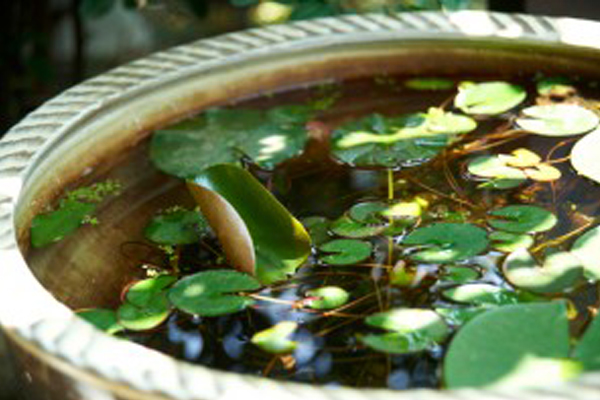Natsutsubaki-Inspired Cool Table Settings for Summer
Jun 03,2013
Natsutsubaki-Inspired Cool Table Settings for Summer
Jun 03,2013
Wherever you go in Japan, you’ll find pieces of tableware with a character all their own. They reflect the country’s cultural diversity and the vision of the artists who made them. Their presence adds sparkle to everyday surroundings. In this series, the owner of a tableware gallery showcases tableware that brightens your day and lends color to the season.
For this installment we visited Eto Aya, proprietor of the gallery Natsutsubaki, which is in a remodeled antique home. We asked her to show us tableware that would look refreshingly cool in the coming rainy season and hot summer months. She selected and coordinated several items from the many on display in the gallery’s elegantly understated interior.
We asked what type of tableware you should choose to create a cool impression in the hot summer months.
“Increasing the proportion of glassware on the table will make it look cooler,” Aya replied. “Unglazed stoneware and lacquerware can look somewhat heavy, and combining them with glass results in a lighter look. Another thing I’d suggest is adding the color silver. The metallic hue of stainless steel and silver creates an icy effect, and metal efficiently conducts heat. So my advice would be to chill metalware in the fridge, then serve cold noodles or salad on it. That will make your dining table look cool and refreshing in summer.”
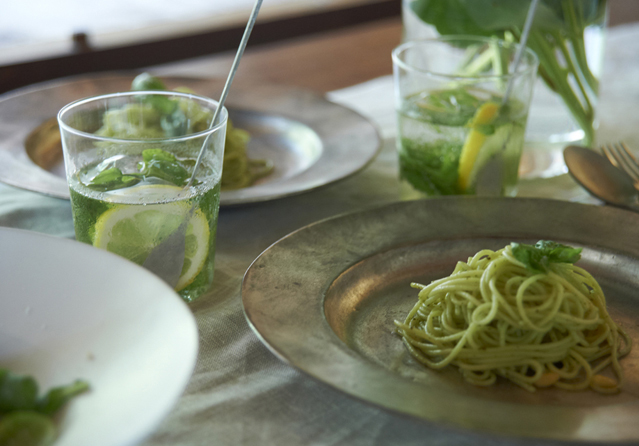
Colors are another key factor.
“Minimizing warm colors like red, orange, or brown in favor of more greens, blues, yellows, and similar elements also leaves a cooler impression. In the case of this table setting, the white linen tablecloth has a summery look thanks to its color and material. You may not usually pay much attention to the overall balance of colors on your dining table, but if you give it a little thought when you’re having guests over, you can create a much cooler, more refreshing look.”
The plants in the vase on the table also play an instrumental role, greatly affecting the impression conveyed. This table setting features Chinese peonies in a large glass container. The white of the flowers is striking.
“The trick is to make good use of plants, vegetables, and fruits. Elements of nature are, along with colors, key to conveying a sense of the changing seasons. A bowlful of tomatoes or cucumbers, say, or the sight of sunflowers makes anyone think intuitively of summer. Skillfully incorporate such elements into your setting to capture the mood of the season.”
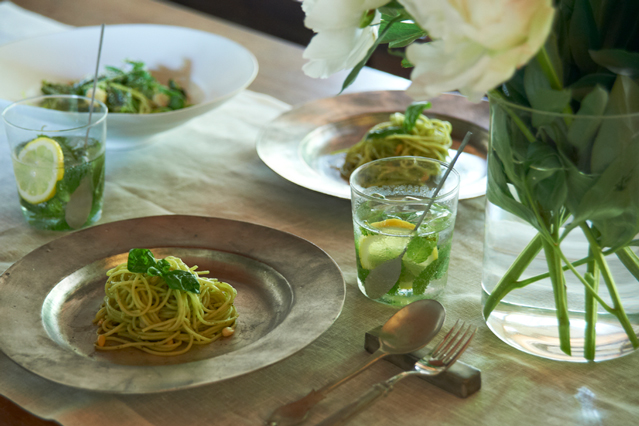
Another setting featured pale green and orange, a combination that took my breath away with its beauty.
“This setting uses complementary colors. It doesn’t look heavy thanks in large part to the impression created by the pale green plates, the handiwork of Anzai Arata and Atsuko. And it’s not just a matter of color. These plates are porcelain rather than ceramic. If ceramics look relatively warm, porcelain has a cool, sharp quality that makes it better suited to summer. Look for effective ways to incorporate it into your setting.”
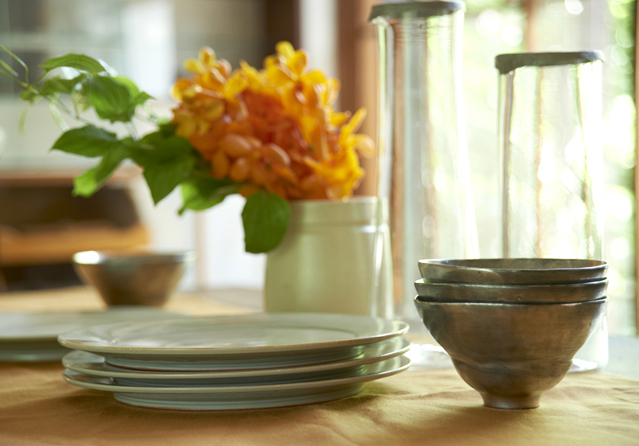
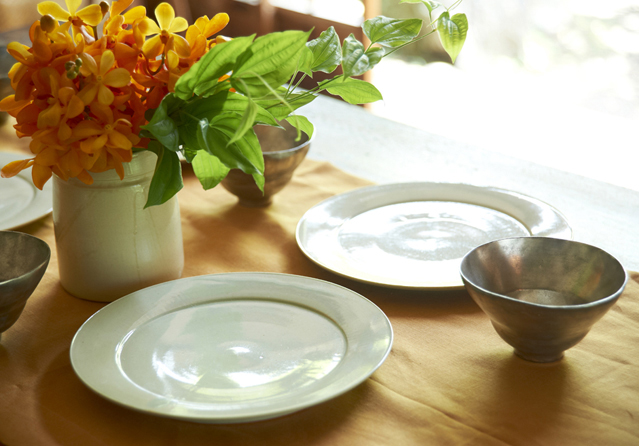
I look around the gallery as I listen to Aya. The tasteful housewares on the shelves blend naturally into the interior. Many of the items display such an exquisite balance of shape and color that it couldn’t be any other way. They aren’t simple ornamental. They each possess their own subtle character stamped with the artist’s personality.
“I’m attracted to pieces that are pared down to the bare essentials while displaying a fine sense of balance and being slanted at just the right angle,” says Aya. “So inevitably, that’s what I’ve ended up collecting.”
Aya sometimes commissions artists to make custom items she would want to use herself. She selected some of these for the settings she showed us, and she told us about the artists who made them.
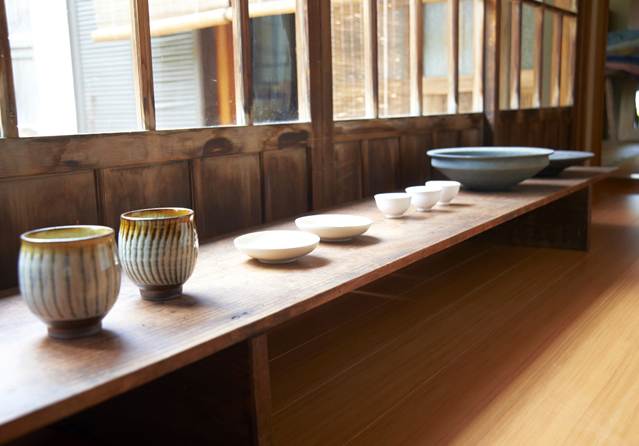
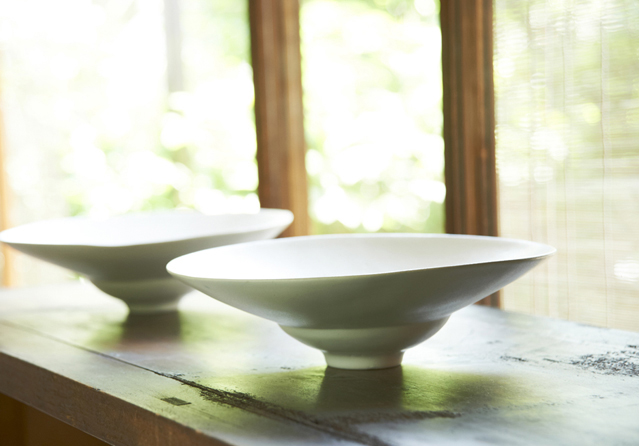
“The glasses and pitchers are the handiwork of an artist working in Toyama named Kinoshita Takara. Her pieces are exquisitely delicate, yet they have that inimitable quality unique to blown glass, which gives them a special charm. She makes glassware while growing rice and other produce in the fields. Her inner strength is reflected in her creations. What I thought would go well with her glassware was stainless steel houseware by Narita Takayoshi. He’s a native of Hokkaido who now works in Minakami, Gunma Prefecture. He works with stainless steel but doesn’t polish it to a shine. Instead, by washing it in acid, he achieves a matte effect that is his hallmark. He overflows with energy as an artist. He’s constantly challenging his limits by creating something new.”
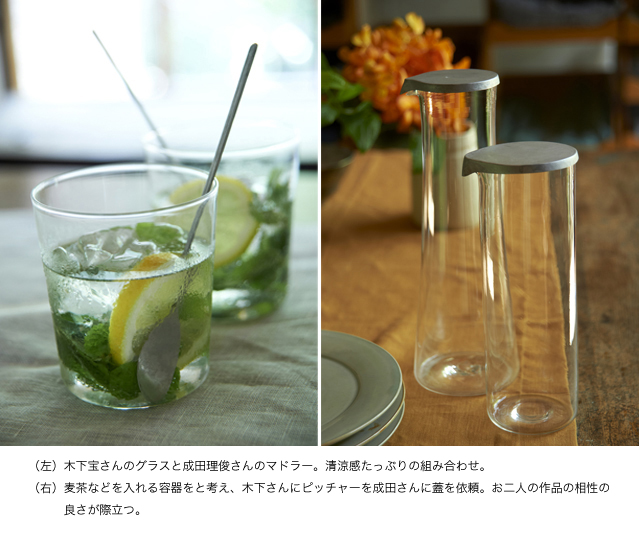
Left: Glasses by Kinoshita Takara and swizzle sticks by Narita Takayoshi. A cool, refreshing combination.
Right: Aya wanted some containers for drinks like barley tea. She therefore commissioned these pitchers from Kinoshita Takara and their lids from Narita Takayoshi. The two artists’ creations go remarkably well together.
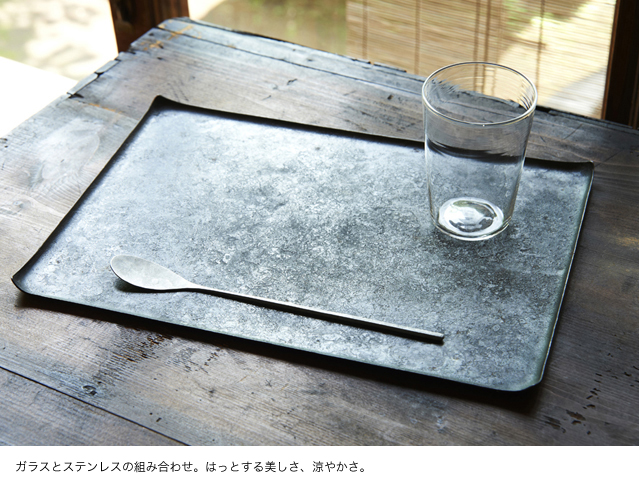
Glass combined with stainless steel. The beautifully cool, refreshing look is stunning.
“The other glassware items, the paperweights, are the work of Oyabu Miyo. Simply placing them unobtrusively on the table or in the garden as decorative objects creates a cooler impression. They also look lovely submersed in water. Oyabu-san, a native of Kyoto, currently has a studio and gallery in Okinawa. She works as an artist while bringing up her three kids. Her pieces are made from recycled glass, and their plumpness and laid-back vibe give a sense of her personality.”
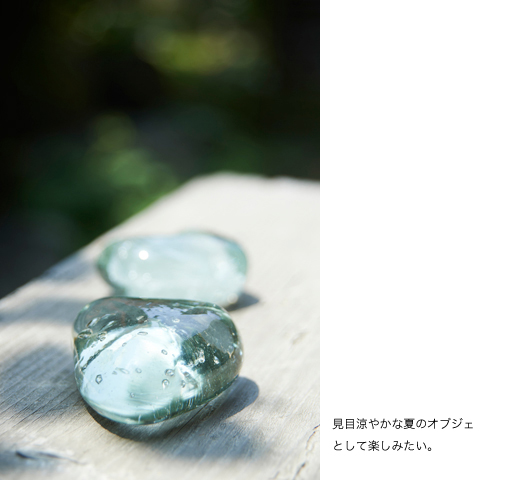
Cool, refreshing-looking objets d’art for summer.
“The pale green porcelain is the work of the husband-and-wife team Anzai Arata and Atsuko, who are based in Ishikawa. These stylish celadon dishes, which beautifully set off food, are a favorite among professional chefs. The Anzais are around my age, and I sometimes get them to make new items for me while seeking their advice.”

With its beautiful color and basic design, this plate nicely sets off a wide range of foods.
“The silver overglaze pewter dishes, as they’re called, are the work of Ando Masanobu, the owner of Galerie Momogusa in Tajimi, Gifu Prefecture. They replicate pewter dishes in ceramic. Their color and shape might leave you wondering what to combine them with and what to serve in them, but they’re quite versatile when you actually try using them. They go equally well with Japanese or Western food.” (See the end of this article for the artist in his own words.)
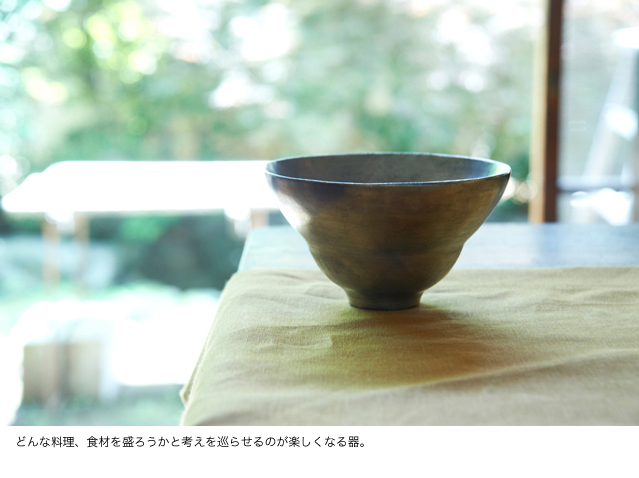
It’s fun to imagine what to serve in this dish.
Are there any precautions to observe when handling delicate glass or metalware dishes? It would be nice to use them as often as possible, so you want to know how to take proper care of them.
“Glass tends to retain water stains, though they’re not very noticeable on recycled glass,” explains Aya. “If the glass is thin, wipe it carefully. I wipe it with a lint-free linen cloth. Another trick for avoiding water stains is polishing the glass after it dries.
“As for Ando-san’s pewter dishes, they’ll tarnish over time, just like your silver accessories. That gives them their own special character, but if it bothers you, burnish them with a cloth for polishing silver accessories. That will restore their original color. Also, avoid heating them in the microwave or cleaning them with a metal scrubbing brush. Either will cause discoloration because they’ll react with the metal. Similarly, if you place an egg boiled in a hot spring on one of these pewter dishes, the metal will react with the egg due to its high sulfur content. The dish will then become tarnished, and you won’t be able to restore it to its original appearance. As long as you follow these simple precautions, you can have fun serving all kinds of foods in these dishes.”
Listening to Aya, I realized that the cool, refreshing effect produced by the tableware she had selected emerged from the interplay of many different factors: the colors used, the impression created by different materials, the seasonal mood imparted by the food and plants on the table, a sensation of cold. Aya says it’s like choosing what to wear.
“In summer, you opt for sheer linen fabrics and light, airy accessories. You ask yourself what colors feel cool and what colors to use as accents. One of the wonderful things about Japan with its four clearly demarcated seasons is that you can experience the changing seasons in various aspects of daily life. Coordinating a table setting doesn’t have to be difficult. Go about it in the same way as you choose what to wear. Then I think you’ll find it a lot of fun.”
So it’s no different from deciding what to put on every day. Now that’s reassuring to know. Coming up with your own table settings while capturing the mood of the season sounds like a cool thing to do on a hot summer’s day.
“Pottery is for the Japanese what jazz is for black people.”
— Ando Masanobu.
During our visit, we also got to talk with artist Ando Masanobu, who had an exhibition on at the Natsutsubaki gallery.
Masanobu was born in the pottery center of Tajimi. He had dreams of a career in the arts, however, and enrolled in art school. There he studied sculpting but never really took to it. He devoted himself to jazz instead.
“I soon hit a serious wall, though. I was Japanese, and I simply didn’t possess the sense of rhythm and ear for music that black people naturally possess. That made me realize that some things just run in the blood.”
Then, after many vicissitudes, he ended up making pottery, a very Japanese art.
“Ceramics are an integral part of Japanese life,” says Masanobu. “In Japan, every member of the family has a set of tableware for their own individual use. That led me to the conclusion that pottery is for the Japanese what jazz is for black people.”
Certainly, the Japanese have always had an affinity for pottery. Masanobu’s creations, though, possess a quality all their own. On being asked about this, he replied:
“There was nothing out there either manufactured or handmade that I would want to use myself. So I had this urge to make niche items — casual wares that I would want to use myself. That’s what inspired me to start making utensils for daily use. The fact I’d studied sculpture and modern art may have had something to do with it. But I’ve always been more interested in the fringe than in the mainstream. I’m into niche stuff. I guess that comes across in my work.”
So what about the silver overglaze pewter dishes used by Aya for her table setting? Pewter is known in Europe as “the poor man’s silver,” and Masanobu was fascinated by it. But antique pewter contains lead, and it can’t be used for daily eating utensils because of the danger of lead poisoning. It therefore occurred to him to replicate it in ceramic. This he did by overglazing pottery with pure silver, though it took him “three years to achieve the desired effect.” The technique he uses involves pressing a slab of clay into a plaster mold called a tatara. It takes more time than using a potter’s wheel, which allows you to produce large quantities with precision. But each piece is distorted in a beautifully organic way. The resulting silver overglaze pewter dishes have a unique feel that matches any meal Japanese or Western.
“People sometimes ask me what I envisioned being served in them. Well, that’s up to the user. They can be used on formal and informal occasions alike. I don’t cook myself, but sometimes when my wife serves something in one of these dishes, it’s like I’m seeing the vessel for the first time. It’s a whole new experience. And when you’ve used these dishes for a while, they take on a nice well-used look. I hope people enjoy how they change over time — and find stunning ways to combine them.”

Natsutsubaki
A gallery in a remodeled traditional home located in a residential neighborhood in the Kamimachi district of Tokyo’s Setagaya Ward. On stepping through the gate, you’re greeted by a beautiful garden, an elegant building, and, inside, housewares and utensils carefully curated by proprietor Eto Aya.
